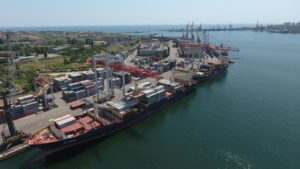
The State Highway Agency of Ukraine (“Ukravtodor”) is preparing for winter by diversifying the supply of technical salt.
“We started preparing for winter in advance. To date, the remaining anti-icing materials from last year are 25,000 tons of technical salt and 159,000 tons of friction materials. We will prepare 283,000 tons of friction materials and 89,000 tons at the beginning of the deterioration of weather conditions . tons of technical salt (50% of the normative need for the entire autumn-winter period). We are preparing, we have the equipment, by the way, this season we plan to attract 4,885 units of equipment and mechanisms,” said Andriy Ivko, the first deputy head of Ukravtodor, in an interview of the “Interfax-Ukraine” agency.
He noted that in connection with the stoppage of work of State Enterprise “Artemsil” due to hostilities in the region and its termination of the supply of technical salt in “Ukravtodor” they were able to find alternative suppliers of this resource.
“We monitored other deposits and production in our country and found an alternative in the west: the Stebnytske deposit of potassium salts in the Lviv region and the Bushtyn deposit in the Zakarpattia region, as well as the bischophyte deposits in the Poltava region. We have already conducted technical tests of the materials – the available raw materials are not inferior in quality the one we purchased earlier, and sometimes it is even better in terms of material meltability,” Ivko noted.
According to him, in addition to the technical characteristics, “Ukravtodor” also took into account the economic component of such supplies.
“We are also working with our European partners, we are talking about ensuring the possibility of purchasing technical salt from Europe. Therefore, on November 1, 2022, we will be 100% ready for winter,” he said.
According to the first deputy chairman of “Ukravtodor”, there are no questions regarding the procurement of fuel either.
In addition, Ivko reminded that the Operational Headquarters for the Elimination of the Consequences of Emergency Situations works at the base of “Ukravtodor”, which includes representatives of the State Emergency Service, the National Police, the State Transport Security Service, JSC “Automobile Roads of Ukraine”, Kyiv military administration and city state administrations, the All-Ukrainian Association of Motor Carriers and the Association of International Carriers of Ukraine.

The total tonnage of grain and other food products exported from three Ukrainian ports as part of the Black Sea Grain Initiative reached 1 million 766.53 thousand tons on September 2, the Joint Coordination Center (JCC) reported.
“A total of 160 flights are allowed: 86 inbound and 74 outbound,” his summary emphasizes.
In particular, on September 2, the SCC authorized the movement of eight vessels carrying a total of 196.29 thousand tons of agricultural products on Saturday.
Among them from the “Southern” port: MAINA in Tarragona (Spain) with 56.5 thousand tons of corn, CANOPUS in Jawaharlal Nehru (India) with 42 thousand tons of sunflower oil, SEA DOLPHIN in Amsterdam (Netherlands) with 31.1 thousand tons, LADY PERLA in Porto Marghera (Italy) with 20.5 thousand tons of corn.
From the port of “Chornomorsk”: BC CALLISTO to Damietta (Egypt) with 31.4 thousand tons of wheat, LADY EVA in Patras (Greece) with 6.12 thousand tons of wheat, SEALOCK to Mersin (Turkey) with 2.07 thousand tons. tons tons of peas, as well as SARA from Odesa to Tekirdag (Turkey) with 6.6 thousand tons.
Two more vessels whose planned departure on Friday was postponed are also expected to depart on Saturday-Sunday: MUBARIZ IBRAHIMOV from Odesa to Tekirdag (Turkey) with 6.6 thousand tons of sunflower oil and NORD VIRGO from “Pivdenny” to Juan (China) ) from 62.34 thousand tons of corn.
In addition, the SCC completed eight inspections of inbound vessels on September 2, and has nine inspections planned for Saturday: six inbound vessels and three outbound.
As reported, on July 22 in Istanbul, at the suggestion of the UN, Ukraine, Turkey and UN Secretary General Antonio Guterres signed an initiative on the safe transportation of grain and food products from the Ukrainian ports of Odesa, Chornomorsk and Pivdenny.

World food prices in August decreased by 1.9% compared to July. Prices have been falling for the fifth month in a row after the all-time high recorded in March.
According to the FAO (Food and Agriculture Organization of the United Nations), the food price index in August amounted to 138 points, which is 1.9% lower than in July. But it remains 7.9% higher than in August last year.
The grain price index in August fell by 1.4% compared to July, but remained 11.4% above the level of August 2021. In August, international wheat prices fell 5.1%. This indicator has been declining for the third month in a row, due to improved crop prospects, especially in Canada, the US and the Russian Federation. At the same time, wheat prices are 10.6% higher than in August last year.
Global corn prices edged up 1.5% in August, largely driven by lower crop prospects in the EU and US due to hot and dry conditions, while resumption of exports from Ukraine prevented prices from rising even higher, the report says.
The price index for vegetable oils in August decreased by 3.3% compared to July, but remains above the level of the previous year. The fall was due to a decrease in world prices for palm, sunflower and rapeseed oils. Soybean oil quotes rose.
The price index for dairy products in August fell by 2% compared to July. The decline continues for the second month in a row, but prices are still 23.5% higher than in the corresponding period last year.
The meat price index in August fell by 1.5%, but it is still 8.2% higher than in August last year. “In August, international quotations of poultry meat fell sharply, which is associated with a reduction in purchases by leading importers amid higher export supply. The decline in world prices for beef is attributed to weak domestic demand in some leading exporting countries, which led to an increase in their export offer , and some increase in supplies from Australia, with pork quotes rising on continued low supply of ready-to-slaughter pigs, while a modest increase in mutton prices due to increased import demand from some European countries, which helped to offset the reduction in purchases from China “, the review says.
The sugar price index in August fell by 2.1%. This index has been falling for the fourth month in a row and has reached its lowest level since July 2021. This is due to an increase in the marginal volume of sugar exports from India and a decrease in ethanol prices in Brazil, which suggests that the volume of sugar cane used for sugar production will also increase, FAO experts say.
The FAO Food Price Index is a weighted average that tracks international price movements for five major food commodity groups.

PJSC “Ukrainian Agrarian Insurance Company” (UASK, Kyiv) in January-June 2022 collected UAH 7.088 million in gross premiums, which is 71.68% less than the volume for the same period a year earlier, the Standard- Rating”, confirming the company’s financial strength rating at the level of “uaAA” on the national scale.
According to a report on the website of the Republic of Armenia, in particular, receipts from individuals of the company decreased by 46.42%, to UAH 0.232 million. There were no premiums from reinsurers in the period under review. Thus, taking into account the share of individuals in gross premiums at the level of 3.27%, legal entities prevailed in the insurer’s client portfolio.
Insurance payments sent to reinsurers for the first half of 2022 decreased by 81.70% compared to the same period in 2021, to UAH 3.417 million. The coefficient of participation of reinsurers in insurance premiums decreased by 26.38 percentage points to 48.21%.
Net premiums decreased by 42.28% to UAH 3.671 million, while earned premiums decreased by 28.09% to UAH 4.451 million.
In the first six months of 2022, the company paid out UAH 1.472 million to its customers, which is 42.05% less than the amount of payments for the same period in 2021, but the level of insurer payments in the period under review increased to 20.77%.
The company’s operating profit amounted to UAH 2.123 million, and net profit amounted to UAH 2.993 million, while in the first half of 2021 there was a net and operating loss.
As of June 30, 2022, the company’s assets increased by 10.48%, to UAH 66.178 million, equity – by 6.53%, to UAH 48.837 million, liabilities showed an increase of 23.34%, to UAH 17.341 million, cash funds and their equivalents increased by 107.63% to UAH 7.051 million.
As of the reporting date, PJSC “Ukrainian Agrarian Insurance Company” formed a portfolio of current financial investments in the amount of UAH 53.209 million, which consisted of deposits in banks with a credit rating of at least uaAA in the amount of UAH 5.831 million, and investments in Government bonds in the amount of UAH 4 million. The presence of such investments had a positive effect on the provision of the insurer with liquid assets, which in total exceeded its liabilities by 3.48 times, the RA notes.
As reported, IC “Ukrainian Agrarian Insurance Company” (formerly IC “Salamander-Dnepr”) has been operating in the country’s market since 1995. According to the Unified State Register of Legal Entities and Individual Entrepreneurs, 98.26% of the authorized capital of the Dobrobut agricultural firm belongs to Astarta-Kyiv Firm LLC.

Export of goods from Ukraine in August increased by 13.9% compared to July to $3.363 billion, while imports decreased by 2.3% to $4.416 billion, the Ministry of Economy reported on Friday.
According to him, as a result, the negative balance of Ukraine’s foreign trade in goods last month decreased to $1.053 billion from $1.569 billion in July and $1.549 billion in June.
“The growth in exports is associated with the partial unblocking of the ports of Greater Odessa. This made it possible to significantly increase the volume of exports of Ukrainian goods. As a result, transportation by sea increased by 85% and amounted to almost 2.9 million tons,” the Ministry of Economy noted.
It indicated that in physical terms, in August 2022, the volume of Ukrainian exports increased by 25%, to 7.296 million tons, while imports decreased by 1%, to 1.961 million tons.
According to the Ministry of Economy, Ukraine exported more than 3 million tons of goods by rail, and 1.36 million tons by road.
At the same time, exporters receive the largest revenue from goods exported by road – $1.48 billion, sea cargo cost $995 million, and rail cargo – $788 million.
“Ukraine relies on the export model of economic growth. Before the full-scale war, our exports amounted to 35% of GDP. The goal of the Government and the Ministry of Economy is to raise it to 50%. 75% of exports should be finished goods and services,” the words of the First Vice -Prime Minister – Minister of Economy Yulia Sviridenko.
The leaders in terms of export value in August were, in particular, sunflower oil – $443 million and corn – $347 million, whose export volumes increased by 30%, to 366 thousand tons and by 31%, to 1.5 million tons, respectively, while export of sunflower seeds amounted to $71 million.
In addition, the list of leaders includes rapeseed – $305 million, including exported 665 thousand tons of this crop of the new crop, and wheat – $213 million, the export of which in August increased 2.3 times compared to July, to 880 thousand tons.
Last month, soybean exports jumped by 30% to 148,000 tons, and in monetary terms to $62 million, while revenue from electricity exports doubled to $73 million, which was the result of the successful integration of the Ukrainian energy sector into ENTSO-E, an energy system of the European Union.
“It is important that confectionery processing products demonstrate a stable upward trend: bakery +19.4%, sugar +9.1%, chocolate +25%,” the Ministry of Economy added, without specifying specific indicators.
At the same time, ore exports fell to 1.4 million tons, and in monetary terms – to $172 million, cable products – by 9.8%, to $89 million, poultry meat – to $67 million.

The administration of US President Joseph Biden is asking the US Congress to allocate additional security and economic assistance to Ukraine in the amount of $11.7 billion, as well as $2 billion in domestic energy supplies to offset the impact of the war on the global energy market, writes in Friday the American edition of The Hill.
“We have rallied the world to support the people of Ukraine and defend our democracy, and we simply cannot let that support for Ukraine dry up,” an unnamed administration official told reporters.
Specifically, the White House is asking Congress to approve $4.5 billion for military equipment and Pentagon resupply, $2.7 billion for defense and intelligence assistance for Ukraine, and $4.5 billion for budgetary support for the government of Ukraine.
The $2 billion request to support domestic energy sources is distributed as follows: $1.5 billion for fuel for nuclear reactors and $500 million for the modernization of the Strategic Petroleum Reserve.
The White House says the funds are needed to maintain the pace of assistance to Ukraine during the first three months of fiscal year 2023, which begins in early October. An administration official said roughly three-quarters of the funds previously approved by Congress for Ukraine had already been spent or disbursed.
The publication recalls that Congress, on a bipartisan basis, has already approved the allocation of more than $53 billion in security, economic and humanitarian assistance to counter the Russian invasion of Ukraine this year. The White House expects that these funds will be enough until the end of the fiscal year.
Both parties support sending aid to Ukraine as it battles more than six months of attacks from Russia, although it is possible that at least some Republicans will doubt the latest funding request.
In addition to increased funding for Ukraine, the White House is also asking Congress to authorize additional billions to fund the federal government’s response to the Covid-19 pandemic, monkeypox response, and disaster relief. The emergency funding request is $47.1 billion.